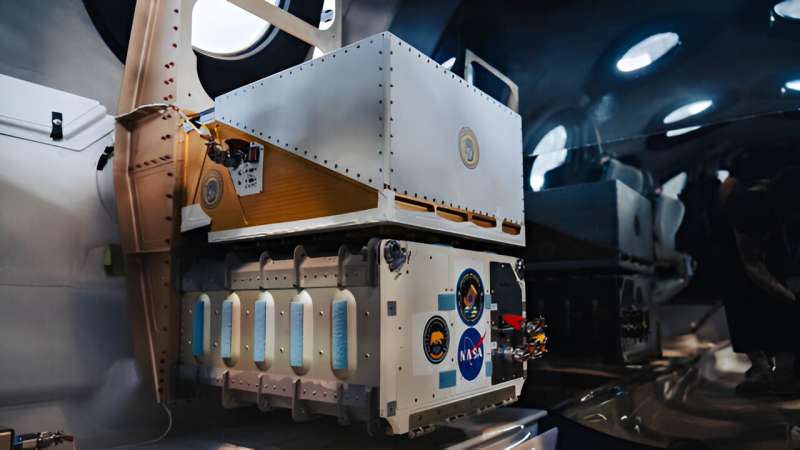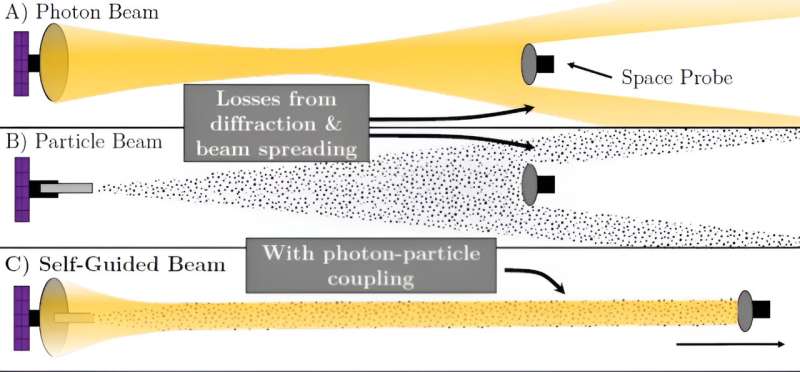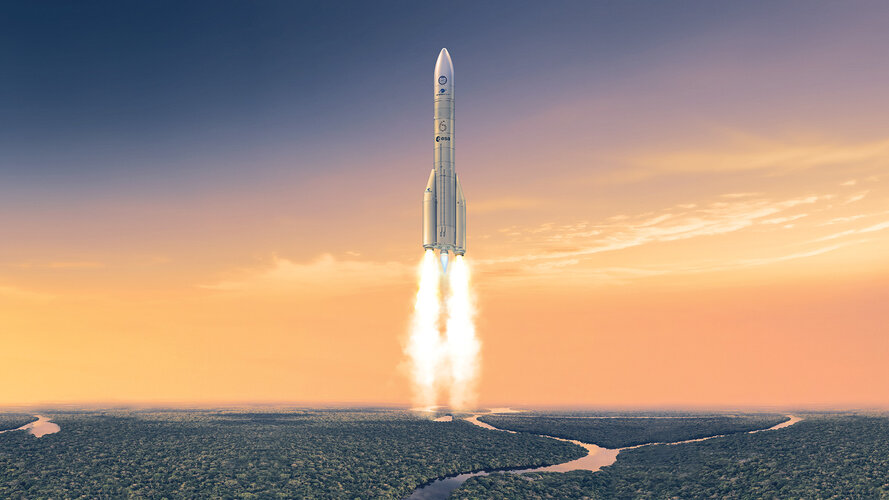Webb admires bejewelled ring
Friday, 05 July 2024 07:00 Image:
Webb admires bejewelled ring
Image:
Webb admires bejewelled ring Europe’s Earth Return Orbiter reaches design maturity
Friday, 05 July 2024 05:39
ESA’s Earth Return Orbiter, the first spacecraft that will rendezvous and capture an object around another planet, passed a key milestone to bring the first Mars samples back to Earth.
Firefly Aerospace Successfully Launches Eight CubeSat Satellites
Thursday, 04 July 2024 16:56 Firefly Aerospace successfully launched its Alpha rocket carrying eight CubeSat satellites into space on Tuesday night from California's Vandenberg Space Force Base. This mission marks a significant achievement following a previous scrub due to ground systems issues.
The CubeSats were launched under NASA's Launch Services Program Venture, providing satellite developers at U.S. universities
Firefly Aerospace successfully launched its Alpha rocket carrying eight CubeSat satellites into space on Tuesday night from California's Vandenberg Space Force Base. This mission marks a significant achievement following a previous scrub due to ground systems issues.
The CubeSats were launched under NASA's Launch Services Program Venture, providing satellite developers at U.S. universities This desert moss has the potential to grow on Mars
Thursday, 04 July 2024 16:56 The desert moss Syntrichia caninervis is a promising candidate for Mars colonization thanks to its extreme ability to tolerate harsh conditions lethal to most life forms. The moss is well known for its ability to tolerate drought conditions, but researchers report June 30 in the journal The Innovation that it can also survive freezing temperatures as low as -196C, high levels of gamma radiation,
The desert moss Syntrichia caninervis is a promising candidate for Mars colonization thanks to its extreme ability to tolerate harsh conditions lethal to most life forms. The moss is well known for its ability to tolerate drought conditions, but researchers report June 30 in the journal The Innovation that it can also survive freezing temperatures as low as -196C, high levels of gamma radiation, Geoscientists dig into why we may be alone in the Milky Way
Thursday, 04 July 2024 16:56 New research by University of Texas at Dallas geoscientist Dr. Robert Stern and a colleague suggests a geological explanation for why conclusive evidence for advanced extraterrestrial (ET) civilizations has not been found, even though the Drake equation predicts that there should be many such civilizations in our galaxy capable of communicating with us.
In a study published online April 12
New research by University of Texas at Dallas geoscientist Dr. Robert Stern and a colleague suggests a geological explanation for why conclusive evidence for advanced extraterrestrial (ET) civilizations has not been found, even though the Drake equation predicts that there should be many such civilizations in our galaxy capable of communicating with us.
In a study published online April 12 Dhruva Space partners with Kinis to provide space-based IoT connectivity in India
Thursday, 04 July 2024 16:56 In a groundbreaking initiative to fortify global satellite connectivity, full-stack Space Engineering solutions provider Dhruva Space and France-based satellite operator global IoT connectivity provider Kinis have strengthened their collaboration to introduce Kinis IoT connectivity in India, and to launch a Kinis IoT payload on Dhruva Space P-30 satellite.
This partnership is focused on Dh
In a groundbreaking initiative to fortify global satellite connectivity, full-stack Space Engineering solutions provider Dhruva Space and France-based satellite operator global IoT connectivity provider Kinis have strengthened their collaboration to introduce Kinis IoT connectivity in India, and to launch a Kinis IoT payload on Dhruva Space P-30 satellite.
This partnership is focused on Dh Icesat-2 Resumes Data Collection After Solar Storms
Thursday, 04 July 2024 16:56 the space agencys ICESat-2 satellite returned to science mode on June 21 UTC, after solar storms in May caused its height-measuring instrument to go into a safe hold. The ICESat-2 team restarted the missions instrument, a lidar called the Advanced Topographic Laser Altimeter System (ATLAS), which is once again collecting precise data on the height of Earths ice, water, forests and land cover. No
the space agencys ICESat-2 satellite returned to science mode on June 21 UTC, after solar storms in May caused its height-measuring instrument to go into a safe hold. The ICESat-2 team restarted the missions instrument, a lidar called the Advanced Topographic Laser Altimeter System (ATLAS), which is once again collecting precise data on the height of Earths ice, water, forests and land cover. No Indonesia aims to build cutting-edge spaceport but faces obstacles
Thursday, 04 July 2024 16:56 Indonesia aims to launch 19 satellites into low-Earth orbit next year, part of an ambitious plan to move the country into the forefront of the world's growing space industry and reduce its reliance on other countries for its satellite data.
The broader program, known as the 2045 space map, is set to begin next year. Officials hope to boost Indonesia's economy and drive foreign direct inves
Indonesia aims to launch 19 satellites into low-Earth orbit next year, part of an ambitious plan to move the country into the forefront of the world's growing space industry and reduce its reliance on other countries for its satellite data.
The broader program, known as the 2045 space map, is set to begin next year. Officials hope to boost Indonesia's economy and drive foreign direct inves Ariane 6 first flight timeline
Thursday, 04 July 2024 14:21 Image:
Ariane 6 first flight timeline
Image:
Ariane 6 first flight timeline EarthCARE offers a sneak peek into Earth’s energy balance
Thursday, 04 July 2024 14:20
Offering a foretaste of what’s to come once it is fully commissioned, ESA’s EarthCARE satellite has returned the first images from its broadband radiometer instrument. These initial images offer a tantalising glimpse into the intricacies of our planet’s energy balance – a delicate balance that governs our climate.
Airbus secures $2.5 billion German military satellite contract
Thursday, 04 July 2024 13:42

Engineers send 3D printer into space
Thursday, 04 July 2024 13:30
Imagine a crew of astronauts headed to Mars. About 140 million miles away from Earth, they discover their spacecraft has a cracked O-ring. But instead of relying on a dwindling cache of spare parts, what if they could simply fabricate any part they needed on demand?
A team of Berkeley researchers, led by Ph.D. student Taylor Waddell, may have taken a giant leap toward making this option a reality. On June 8, they sent their 3D printing technology to space for the first time as part of the Virgin Galactic 07 mission.
Their next-generation microgravity printer—dubbed SpaceCAL—spent 140 seconds in suborbital space while aboard the VSS Unity space plane. In that short time span, it autonomously printed and post-processed a total of four test parts, including space shuttles and benchy figurines from a liquid plastic called PEGDA.
"SpaceCAL performed well under microgravity conditions in past tests aboard parabolic flights, but it still had something to prove," said Waddell.
A concentrated beam of particles and photons could push us to Proxima Centauri
Thursday, 04 July 2024 13:00
Getting to Proxima Centauri b will take a lot of new technologies, but there are increasingly exciting reasons to do so. Both public and private efforts have started seriously looking at ways to make it happen, but so far, there has been one significant roadblock to the journey—propulsion.
To solve that problem, Christopher Limbach, now a professor at the University of Michigan, is working on a novel type of beamed propulsion that utilizes both a particle beam and a laser to overcome that technology's biggest weakness.




